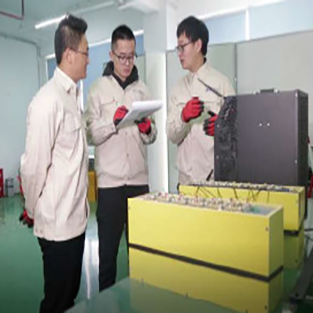
Lithium-ion batteries are the backbone behind our modern gadgets. To ensure these vital power sources function optimally for as extended a time as possible, proper care is paramount.
Ignoring battery well-being can lead to premature failure, leaving you stranded with a useless device. By adopting a few simple tips, you can remarkably prolong the lifespan of your lithium-ion batteries.
- Refrain from extreme temperatures, as both heat and freezing temperatures can damage battery performance.
- Keep your batteries at a moderate room temperature when not in use.
- Power up your batteries regularly, but avoid overcharging them as this can strain the battery.

Utilize a quality charger designed specifically for your device type. Refrain from using generic chargers, as they can incur a risk to your battery and equipment. Regularly observe the battery's health by paying attention to its charging time and consumption level. Think about purchasing a battery case to safeguard your device from accidental drops which can affect battery performance.
2. Optimizing Lithium-ion Battery Performance Through Smart Charging
Smart charging practices can significantly enhance the lifespan and overall performance of lithium-ion batteries. implementing smart charging techniques involves monitoring battery state and optimizing charging variables accordingly. This proactive approach helps to reduce overcharging, which can cause detrimental effects on the battery's chemistry.
Furthermore, smart charging algorithms detect charging patterns and adjust charging behaviors to suit individual user needs. By minimizing unnecessary charging cycles and stabilizing optimal battery temperatures, smart charging contributes to a longer and enhanced lifespan for lithium-ion batteries.

Avoiding Overcharging: Protecting Your Lithium Batteries

Overcharging your lithium ion packs can cause a slew of problems, from reduced lifespan to potential safety hazards. It's crucial to make certain that you're not leaving your devices plugged in for extended periods once they reach full charge. Most modern devices have built-in circuitry to prevent overcharging, but it's always best to err on the side of caution. Consider using a power strip to automatically disconnect your device after a set amount of time. This will help preserve your battery's lifespan and keep it performing at its best.
Maintaining Temperature Control: Keeping Lithium Batteries in Their Optimal Zone

Lithium batteries are sensitive devices that thrive within a specific temperature range. Shifts in temperature can significantly impact their performance, lifespan, and even safety. Keeping your lithium batteries at the ideal heat level is crucial for enhancing their efficiency and longevity.
To ensure optimal performance, it's essential to store your batteries in a moderate environment, ideally between 0°C and 25°C. Avoid exposing lithium batteries to extreme heat, as this can negatively affect their internal components.
- Think about using a battery cooler to protect your batteries from temperature extremes.
- Regularly check the temperature of your batteries, especially during storage.

Lithium Battery Limits
Deep discharge issues are a serious danger for lithium power cells. When a battery is deeply discharged, the chemical reactions inside stop and can trigger lasting damage. This can hamper the battery's capacity and life. Repeated deep cycles can ultimately Lithium Battery Maintenance destroy of the lithium pack. To prevent these threats it's crucial to always maintain your lithium batteries within their recommended limits and avoid letting them reach a depth.
6. Storage Solutions for Lithium Batteries: Ensuring Long-Term Viability
Proper storage of lithium batteries is paramount to ensure their longevity over the long term. Utilizing strategic storage strategies can significantly mitigate degradation and extend the lifespan of these valuable power sources.

A key element is maintaining a cool and dry environment to deter factors that can accelerate battery degradation. Furthermore, minimizing exposure to extreme conditions is crucial.

A well-designed storage infrastructure should include features like temperature control, humidity regulation, and proper ventilation to create an optimal setting. Moreover, it's essential to store batteries correctly to prevent physical damage.
Adhering to manufacturer recommendations for storage period and discharging levels can also contribute to long-term reliability. By prioritizing these storage solutions, we can maximize the lifespan of lithium batteries and ensure their continued viability.
Inspecting and Inspecting Lithium Batteries: A Preventative Maintenance Checklist
Regularly maintaining your lithium batteries is crucial for optimizing their lifespan and ensuring optimal performance. Here's a preventative maintenance checklist to help you keep your batteries in top shape:
- Visually inspect damage such as cracks, punctures, or swelling.
- Gently remove any dirt or debris from the battery contacts using a soft cloth.
- Verify that the battery housing is securely attached.
- Store batteries in a cool, dry environment away from direct moisture.
Detecting Signs of Lithium Battery Degradation
Over time, lithium-ion batteries naturally degrade. This means their ability to store and deliver power gradually reduces. Paying attention to certain signs can help you assess if your battery is experiencing degradation.
Here are some key things to {look for|observe:
* **Reduced Battery Life:** One of the most noticeable signs is a significant reduction in how long your device lasts on a single charge.
* **Slower Charging Times:** If your battery takes much a extended period to fully charge, it could be suggesting degradation.
* **Frequent BatteryLoss:** You might find that your battery drains more quickly than usual, even when you're not actively using demanding software.
Riding on Lithium Battery Life: Managing Charge Cycles Effectively
Electric bikes have revolutionized transportation/commute/mobility, offering a sustainable and efficient way to get around. However, the lifespan of lithium batteries, which power these e-bikes, is a crucial consideration/factor/aspect. Intensive cycling can put stress on the battery, accelerating/shortening/reducing its life cycle. To maximize/extend/preserve the lifespan of your lithium battery, it's essential to implement/adopt/follow effective charge cycle management strategies.
- Charging/Powering/Refueling your battery fully after each ride can lead to overcharging, which can degrade/damage/harm the battery's internal components.
- Storing/Leaving/Parking your e-bike in a cool/shaded/protected environment helps prevent extreme temperatures from affecting/impacting/influencing the battery's performance.
- Regularly/Periodically/Continuously monitoring the battery's charge level and avoiding deep discharges can help optimize/enhance/improve its lifespan.
Debunking: Common Misconceptions about Lithium Battery Maintenance
Let's eliminate the confusion surrounding lithium battery care. Contrary to popular belief, you needn't constantly monitor your batteries for a perfect charge. In fact, frequently filling them to 100% can shorten their lifespan. Similarly, the belief that lithium batteries must be fully discharged before topping off is also incorrect.
- Rather, aim for a cycling pattern between 20% and 80%
- Storing your lithium battery at room temperature is ideal, as extreme cold can damage its performance.
Remember, proper handling extends the life of your lithium batteries.
Balancing Your Lithium Battery Pack: Ensuring Equal Discharge and Charge
Lithium-ion batteries are incredible power sources, but they rely on each cell operating harmoniously. To achieve optimal performance and lifespan, it's crucial to equalize your battery pack.
Imagine your battery pack as a team of athletes - if some are functioning harder than others, the overall team suffers. Balancing ensures each cell contributes equally during both charging and discharging cycles. This prevents stress on individual cells, extending their lifespan and maximizing the pack's overall capacity.
There are a few methods for balancing your lithium battery pack. Some charge controllers include built-in balancing circuitry, automatically regulating the voltage across each cell. Alternatively, you can use external balancers that connect to your battery pack and manually redistribute charge between cells.
Regardless of the method you choose, regular balancing is essential for maintaining your lithium-ion battery's health and performance.
Utilizing Battery Management Systems (BMS) for Optimal Lithium Battery Health
Implementing a sophisticated Battery Management System|Power Control Unit|Electronic Monitoring Circuit (BMS) is paramount to maximizing the lifespan and performance of lithium-ion batteries. A robust BMS acts as a protector against detrimental factors such as overcharging, overdischarging, and temperature variations. By carefully controlling these parameters, a BMS promotes the long-term health of your lithium battery, resulting in increased cycle life and enhanced overall durability.
13. The Science Behind Lithium Battery Degradation: Understanding the Mechanisms
Lithium-ion batteries are widely utilized due to their high energy density and lightweight nature. However, these batteries are susceptible to degradation over time, which impacts their performance and lifespan. This section delves into the scientific underpinnings of lithium battery degradation, exploring the various mechanisms responsible for this decline.
One primary cause of degradation is the formation of a solid-electrolyte interface (SEI) on the anode surface during initial charging cycles. The SEI layer, while crucial for battery operation, can transform over time, leading to increased resistance and reduced lithium ion transport.
Furthermore, side reactions between the electrolyte and electrode materials can occur, resulting in the formation of residues that restrict lithium ion movement. These deposits can also disintegrate during cycling, leading to increased resistance and capacity fade.
Another contributing factor is the physical changes throughout the electrode materials themselves. During repeated charge-discharge cycles, lithium ions insert into the electrode lattice, causing tension. This build-up of strain can ultimately lead to structural degradation, such as cracks or grain fragmentation.
DIY Lithium Battery Maintenance: Simple Steps for Extended Life
Keeping your lithium batteries in tip-top shape requires minimal effort! With a few easy steps, you can maximize their lifespan and provide optimal performance.
- Initiate by storing your batteries in a temperate environment. Avoid extremes of temperature, as these can degrade the battery's composition.
- Ensure the battery terminals clean and free from corrosion. A moist cloth with a mixture of salt and water can efficiently remove any buildup.
- Avoid overcharging your batteries, as this can stress the battery's internal components and reduce its lifespan.
Implement these simple maintenance tips, you can help your lithium batteries last longer and perform at their best.
Repurposing Lithium Batteries: Responsible Practices
Lithium batteries power our devices, but their disposal requires careful consideration. These rechargeable packs contain valuable components that can be salvaged through responsible reprocessing methods. Engaging proper disposal practices helps reduce environmental harm and conserve valuable resources.
Upon discarding your lithium batteries, it's crucial to inspect them for any damage or leaks. Keep them in a safe and dry spot to prevent accidental release. Reach out your local waste management authority or device retailers for information on designated drop-off points. Explore third-party battery repurposing programs that specialize in handling lithium batteries safely and efficiently.
Following these practices ensures the conservation of our planet's resources and promotes a circular approach to technology.
Picking the Right Charger for Your Lithium Batteries: Preventing Overcharging
When it comes to filling up your lithium-ion devices, picking the suitable charger is completely essential. An improper charger can lead excessive charging, which can harm your battery and limit its lifespan significantly.
To prevent this, make sure to opt for a charger that is specifically designed for your battery type. Look at the charger's specifications to guarantee that it provides the correct voltage and ampereage for your gadget.
A good rule of thumb is to examine your charger's manual for the ideal charger specifications.
Lithium Battery Safety First: Handling and Storage Precautions
When working with lithium batteries, safety should always be your top concern. To minimize the risk of dangerous incidents, it's crucial to follow proper handling and storage guidelines. Firstly, verify that your batteries are from a reliable source. Always inspect your batteries for any apparent damage such as dents, cracks, or swelling. Stay clear of exposing lithium batteries to intense temperatures, as this can increase the risk of fire.
- Place your batteries in a dry location, away from heat sources.
- Never disassemble or modify lithium batteries. Doing so can result in potential damage.
- Disconnect your devices from power when not in use to prevent overcharging and potential battery damage.
If you experience any unusual behavior with your lithium batteries, such as overheating, swelling, or leaking, immediately cease use and contact a qualified professional for assistance. Remember, prioritizing safety when handling and storing lithium batteries is essential to protect yourself and others.
Optimizing Battery Life Through Smart Charging
Lithium-ion batteries power our gadgets, and understanding how to charge them properly can significantly boost their lifespan. Employing smart charging habits can help you maximize battery performance, ensuring your devices are always ready when you need them.
- Initially, avoid fully draining your battery before recharging it. Striving for a consistent charge level between 20% and 80% is generally recommended.
- {Secondly|Next|, remember that extreme temperatures can negatively impact battery life. Store your devices in a cool, dry place when not in use.
- Lastly, consider using a smart charger that monitors and adjusts the charging flow to prevent overcharging and extend battery lifespan.
Recognizing Warranty Implications for Lithium Battery Maintenance
Lithium-ion battery coverage are crucial to consider when planning maintenance regimes. Regular use and improper care can potentially void your warranty, leaving you responsible for costly repairs. Familiarize yourself with the detailed terms outlined in your battery's warranty documentation to prevent any unforeseen issues. This knowledge empowers you to conduct maintenance tasks that comply with warranty conditions, ensuring your battery remains protected and performs optimally over its lifespan.
Lithium-Ion Battery Evolution: Extending Lifespan
The realm of lithium battery technology is continuously evolving, with researchers and engineers relentlessly pursuing advancements that enhance longevity. One of the key challenges facing this sector is the finite lifespan of batteries, which inevitably degrades over time due to factors like repeated charging cycles and exposure to extreme temperatures. To address this issue, a tide of innovative solutions is emerging, promising to increase the operational life of lithium batteries dramatically.
These advancements encompass a wide range of strategies, including novel electrode materials, enhanced electrolyte formulations, and sophisticated battery management systems. By fine-tuning these critical components, researchers aim to decrease internal stress, improve charge acceptance, and ultimately delay the onset of battery degradation.
The quest for longer-lasting lithium batteries has far-reaching implications across numerous industries. From electric vehicles and consumer electronics to renewable energy storage and medical devices, the ability to drive applications for extended periods without requiring frequent recharging is vital. As research progresses, we can anticipate a future where lithium batteries offer unprecedented levels of durability, enabling a more sustainable and efficient technological landscape.
Comments on “Maximizing Lithium Battery Lifespan: A Guide to Proper Care”